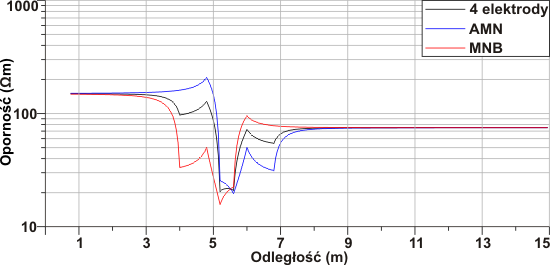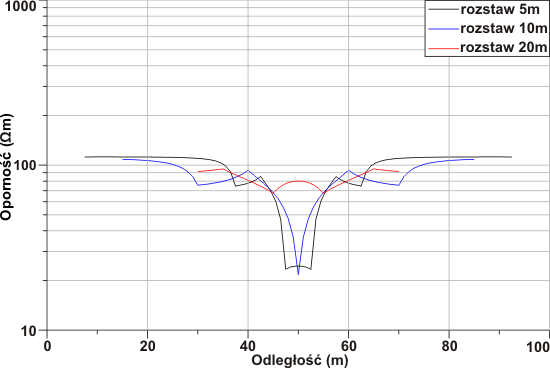Main Page | Knowledge base | Geophysics | Resistivity surveys | Resistivity surveys by profiling technique
RESISTIVITY SURVEYS BY PROFILING TECHNIQUE
Soil testing by electrical profiling method the same arrays as for sounding (Schlumberger’s, Wenner’s etc.) are used. Electrical profiling is a basic resistivity survey technique about moving the whole array along the profile with unchanged geometry. The assumption of electrical profiling is the constant depth of investigation.

Resistivity profiling for 3 different arrays
During profiling, resistivity in distance direction are estimated. The result is a variability of apparent geoelectrical resistance curve along the profile line. Interpretation of the obtained curves (field) is to determine changes in the horizontal substrate, tectonic, fractures zones and their shape, inserts of high and low small layers or facies changes within the same layer as well.

Resistivity profiling for 3 different array spreads
Both electrical profiling and sounding are one-dimension (1D) techniques which means that resistivity variation are determined respectively in horizontal or vertical direction. Proper selection of the method is very important because depends on the geological conditions in tested area and on the shape of explored/identified objects. We use electrical soundings when we expect horizontal or slightly inclined boundaries and electrical profiling are used for sleep or vertical boundaries.
Main application of geoelectrical method is determination of the resistivity of the ground e.g. for pipeline foundation and other linear objects where is important to know the distribution of the resistivity on the whole track in continuous way. Such data can be used to calculate corrosivity, water aggresiveness or for proper grounding for objects.
More advanced method is electrical resistivity tomography which is combination of electrical sounding and profiling in the same time. Tomography allows to characterize the variation of resistivity in the ground-rock substrate in much more efficient way.










